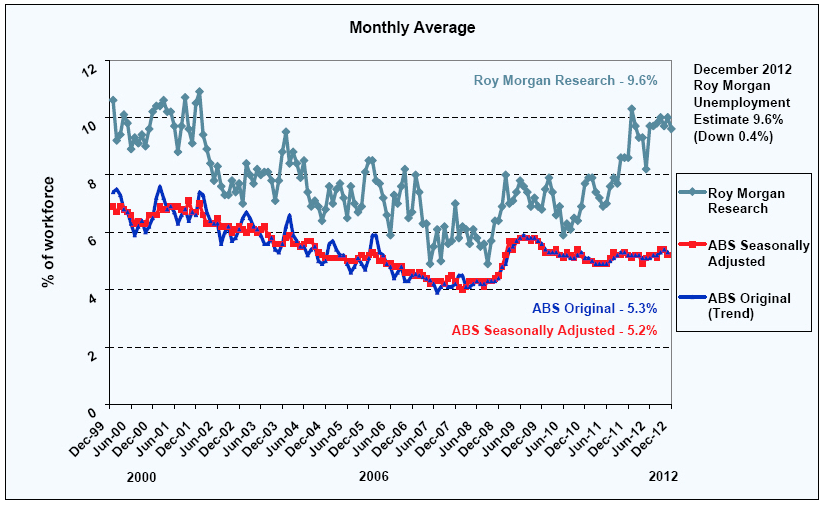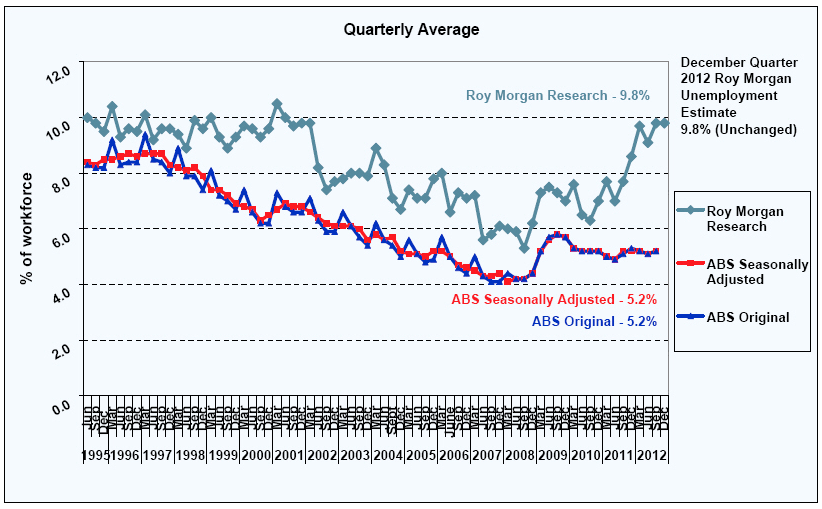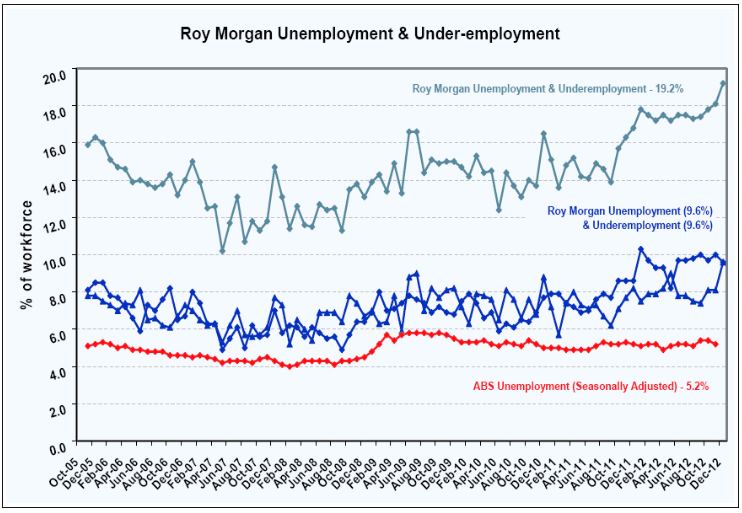
Missed this yesterday, but Roy Morgan Research released its labour force estimates for the month of December, which registered a non-seasonally adjusted -0.4% fall in the unemployment rate to 9.6% (h/t the Patrician):
- In December 2012 an estimated 1.176 million Australians (9.6% of the workforce, down 0.4% in a month) were unemployed, and the Australian workforce* was 12,260,000, comprising 7,242,000 full-time workers (down 135,000); 3,842,000 part-time workers (up 197,000) and 1,176,000 looking for work (down 53,000) according to Roy Morgan.
- A further 1,178,000 Australians were under-employed – working part-time and looking for more work. This is 185,000 more than a month ago, and represents 9.6% of the workforce* (up 1.5%).
- In total 2.354 million Australians were unemployed or under-employed in December. This is 132,000 more than last month and represents 19.2% (up 1.1%) of the workforce. This is also up a large 342,000 over the past 12 months since December 2011.
- Driving this rise over the past 12 months are the large increases in under-employment — 1,178,000 (up 200,000) and part-time unemployment — 590,000 (up 100,000 since December 2011) and a smaller increase in full-time unemployment, up 42,000 to 586,000.
- The latest Roy Morgan unemployment estimate of 9.6% is well above the 5.2% currently quoted by the ABS for November 2012…
Gary Morgan says:
“Today’s Roy Morgan December employment estimates show Australian unemployment falling to 9.6% (1,176,000, down 53,000 in a month). However, the large rise in Australia’s under-employment to 1,178,000 (up 185,000) means a total of 2,354,000 (up 132,000) Australians (19.2%, up 1.1%) are either unemployed or under-employed — a new record high.
“The small increase in the workforce (up 9,000) masks an increase in part-time jobs (up 197,000) at the expense of full-time jobs (down 135,000).Similarly the decrease in unemployment (down 0.4% to 9.6%) is driven by a reduction in the number of people looking for part-time jobs, and masks the increase in people looking for full-time work. Analysis of the dynamics of employment in Australia suggests a substantial shift away from full-time work to part-time work with a consequent increase in people working part-time looking for full-time work or more hours (under-employed).
“This record high number of Australians either looking for work or looking for more work makes it imperative that the RBA cuts Australian interest rates (currently amongst the highest in the developed world at 3%) at the RBA’s first meeting for 2013 — scheduled for the first Tuesday of February.”
This Roy Morgan survey on Australia’s unemployment and ‘under-employed’* is based on weekly interviews covering January 2007 — December 2012 and in total 311,302 Australians aged 14 and over were interviewed face-to-face including 3,751 interviews in December 2012.
*The ‘under-employed’ are those people who are in part-time work or consultants who are looking for more work. (Unfortunately the ABS does not measure this figure in their monthly unemployment survey.)
Roy Morgan’s methodology is explained as follows:
The Roy Morgan Unemployment estimate is obtained by surveying an Australia-wide cross section by face-to-face interviews. An unemployed person is classified as part of the labour force if they are looking for work, no matter when. The results are not seasonally adjusted and provide an accurate measure of monthly unemployment estimates in Australia.
The Australian Bureau of Statistics Unemployment estimates are obtained by mostly telephone interviews. Households selected for the ABS Survey are interviewed each month for eight months, with one-eighth of the sample being replaced each month. The first interview is conducted face-to-face. Subsequent interviews are then conducted by telephone.
The ABS classifies an unemployed person as part of the labour force only if, when surveyed, they have been actively looking for work in the four weeks up to the end of the reference week and if they were available for work in the reference week.
The Australian Bureau of Statistics Unemployment estimates are also seasonally adjusted.
For these reasons the Australian Bureau of Statistics Unemployment estimates are different from the Roy Morgan Unemployment estimate.
Gary Morgan’s concerns regarding the ABS Unemployment estimate is clearly outlined in his letter to the Australian Financial Review, which was not published!
The key charts from the Roy Morgan Research labour force release are provided below:




